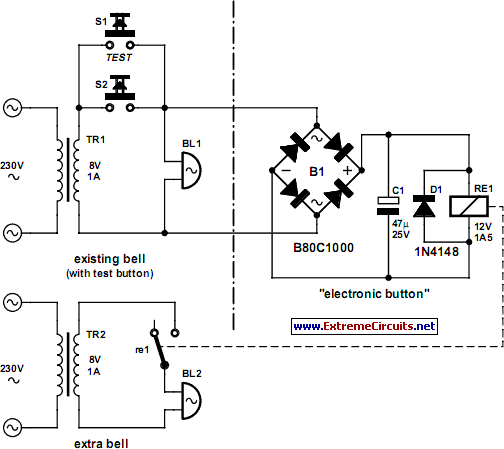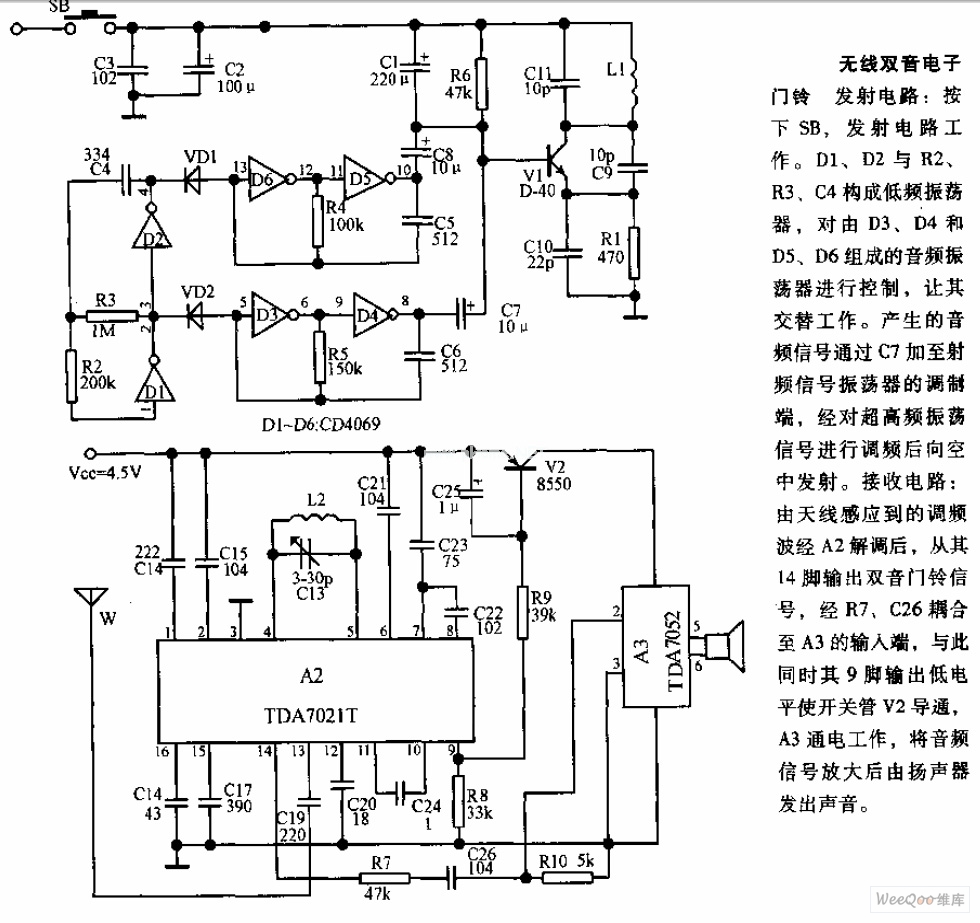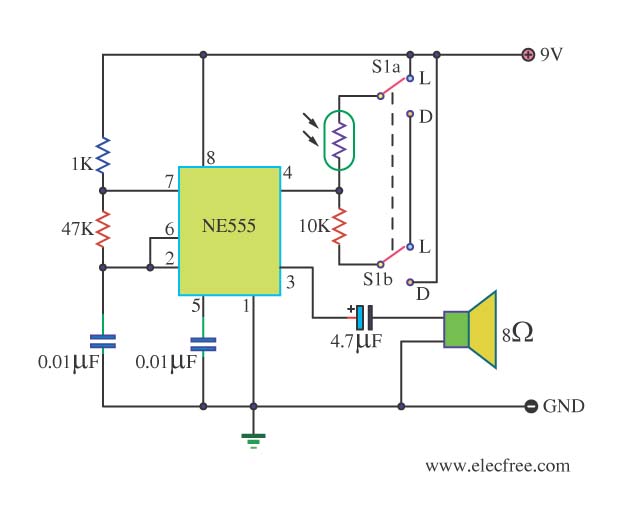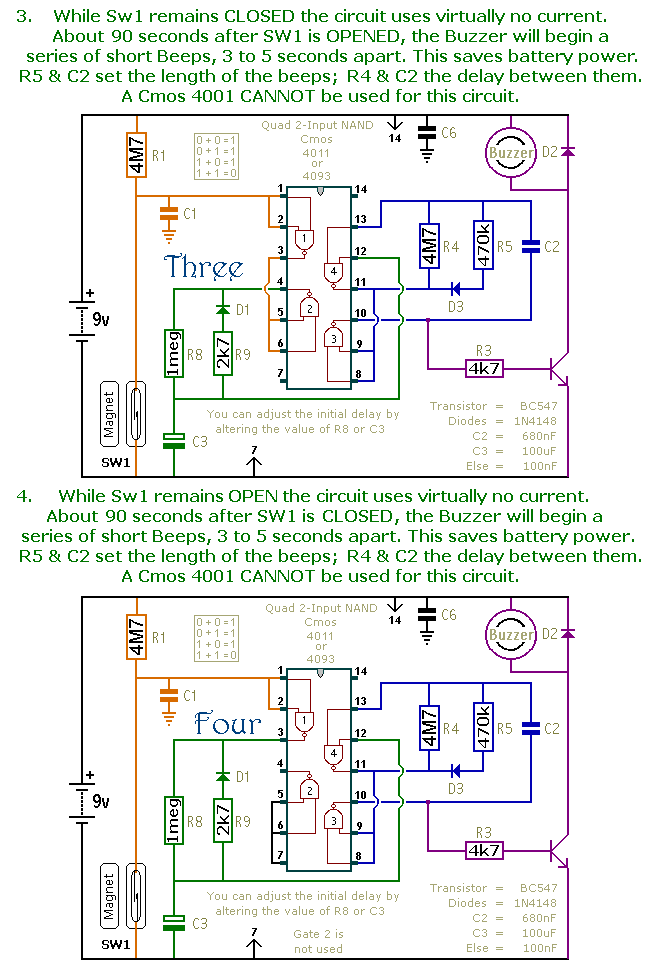
Bell Alarm

When using a lamp with a motion sensor for outdoor lighting, the original electrical switch is no longer required. By replacing the switch with the described circuit, an acoustic signal will be generated each time the outdoor lamp is activated, functioning somewhat like an alarm or doorbell. The operating principle is straightforward: a circuit that causes a voltage drop of only a few volts is connected in series with the lamp. Since the circuit requires a DC voltage, the current for the lamp is routed through a bridge rectifier. The voltage drop across the circuit is determined by resistor R1. Capacitor C1 serves to smooth the raw DC voltage. It is important to note that this is not an example of peak rectification, but rather averaging, which results in the voltage on C1 being lower than expected. Ultimately, the DC voltage on C1 approaches the average voltage across R1. For instance, with a 100-W lamp, assuming a resistance of 529 ohms, and ignoring the voltage across the diodes and R1, the average current is approximately 0.39 A (not 0.43 A). This is due to the average mains voltage being around 207 V, yielding a voltage of approximately 8.5 V on C1. Since the buzzer and transistor T1 draw only a few milliamperes from C1, the actual voltage will vary by at most a few tenths of a volt. A suitable DC buzzer with a wide operating voltage range, such as the CEP-2260A (available from Digi-Key and other suppliers), should be used. The charging time of capacitor C2 determines how long the buzzer remains activated, typically for a few tenths of a second. To extend this duration, the value of R2 can be increased, which is advisable for the mentioned buzzer type. Depending on the lamp's power, R1 may need adjustment; for a 150-W lamp or larger, R1 should be halved to prevent excessive power dissipation, which is approximately 3 watts in the described example. Special attention should be given to the bridge rectifier, as a significant current can flow momentarily when the lamp is cold-started. A 250V, 1.5-A bridge rectifier is sufficient for a 100-W lamp, while higher wattages may require more robust diodes such as the 1N5408 (1000 V / 3 A). Due to the heat generated by R1, ensure it is spaced appropriately from other components in the circuit. Additionally, as the entire circuit connects to mains voltage, adjustments should never be made while the circuit is powered. It is advisable to test the circuit before installation in the switch box.
The described circuit integrates a motion sensor lamp with an acoustic signaling feature, enhancing outdoor lighting systems. The series connection of components allows for the controlled operation of the lamp while simultaneously generating an alert sound. The use of a bridge rectifier is crucial for converting AC mains voltage to a usable DC voltage for the circuit. The design ensures that the acoustic signal activates immediately upon lamp operation, providing instant feedback to the user.
Resistor R1 is a critical component, as it regulates the voltage drop necessary for the circuit's operation. The choice of R1's value directly affects the current flow and the resulting acoustic signal. In scenarios involving higher wattage lamps, careful consideration of R1's resistance is essential to prevent overheating and ensure reliable operation. Capacitor C1 plays a vital role in smoothing the output voltage, ensuring that fluctuations do not adversely affect the performance of the buzzer and the overall circuit functionality.
The bridge rectifier must be selected based on the expected load current, particularly for applications involving higher wattage lamps. The rectifier's specifications should accommodate the peak currents experienced during lamp activation. Furthermore, the heat dissipation properties of R1 necessitate adequate spacing and heat management strategies within the circuit layout to maintain optimal performance and longevity.
Overall, this circuit design exemplifies an innovative approach to integrating acoustic signaling with outdoor lighting, enhancing both functionality and user experience. Proper component selection, layout considerations, and adherence to safety protocols will ensure a successful implementation of this circuit in practical applications.If you use a lamp with a motion sensor for outdoor lighting, the original electrical switch is actually no longer necessary. If you replace the switch with the circuit described here, an acoustical signal will be generated each time the outdoor lamp is switched on.
It`s thus somewhere between an alarm and a doorbell. The operating principle is simple. A circuit that causes a voltage drop of only a couple of volts is connected in series with the lamp. As the circuit needs a DC voltage, the current for the lamp is passed through a bridge rectifier. The voltage drop across the circuit is determined by R1. The function of C1 is to smooth the raw DC voltage. Note that this is not an example of peak rectification, but instead of averaging. For this reason, the voltage on C1 is lower than you might expect. Ultimately, the DC voltage on C1 reaches the same value as the average voltage across R1. For example, consider what happens with a 100-W lamp. For convenience, we can assume that the lamp has a resistance of 529 R. If we ignore the voltage across the diodes and the voltage across R1, the current is approximately 0. 39 A on average (not 0. 43 A). This is because the average mains voltage is only 207 V = (230 G— v2) G· (p/2). This yields a voltage of approximately 8. 5 V on C1. As the buzzer and T1 only draw a few milliampG¨res from C1, in practice the voltage will differ from this value by at most a few tenths of a volt.
Here you should use a DC buzzer with a large operating voltage range. A good example is the CEP-2260A, which has a voltage range of 3 20 V (available from Digi-Key and other online sources). The charging time of C2 determines how long the buzzer remains energised, and here it will be a few tenths of a second.
Depending on how much current the buzzer draws, you can increase the value of R2 in order to extend the time (this is certainly necessary with the above-mentioned buzzer type). Depending on the lamp power, you can consider adjusting the value of R1. This will certainly be necessary if you use a 150-W lamp or larger. In this case, cut the value of R1 in half, primarily because the power dissipation will otherwise be too large.
In the example described here, it is around 3 watts. The bridge rectifier also deserves special attention. A large current can flow briefly when the lamp is switched on cold`. A 250V, 1. 5-A bridge rectifier is adequate for a 100-W lamp, but heavier-duty diodes are necessary with higher lamp power such as the 1N5408 (1000 V / 3 A). Due to the heat generated by R1, make sure that R1 is located a certain distance away from the other components in the assembled circuit.
Also bear in mind that the entire circuit is connected to mains potential. Never make any adjustments while the circuit is connected to the mains! It`s thus a good idea to test the circuit before fitting it into the switch box. 🔗 External reference
The described circuit integrates a motion sensor lamp with an acoustic signaling feature, enhancing outdoor lighting systems. The series connection of components allows for the controlled operation of the lamp while simultaneously generating an alert sound. The use of a bridge rectifier is crucial for converting AC mains voltage to a usable DC voltage for the circuit. The design ensures that the acoustic signal activates immediately upon lamp operation, providing instant feedback to the user.
Resistor R1 is a critical component, as it regulates the voltage drop necessary for the circuit's operation. The choice of R1's value directly affects the current flow and the resulting acoustic signal. In scenarios involving higher wattage lamps, careful consideration of R1's resistance is essential to prevent overheating and ensure reliable operation. Capacitor C1 plays a vital role in smoothing the output voltage, ensuring that fluctuations do not adversely affect the performance of the buzzer and the overall circuit functionality.
The bridge rectifier must be selected based on the expected load current, particularly for applications involving higher wattage lamps. The rectifier's specifications should accommodate the peak currents experienced during lamp activation. Furthermore, the heat dissipation properties of R1 necessitate adequate spacing and heat management strategies within the circuit layout to maintain optimal performance and longevity.
Overall, this circuit design exemplifies an innovative approach to integrating acoustic signaling with outdoor lighting, enhancing both functionality and user experience. Proper component selection, layout considerations, and adherence to safety protocols will ensure a successful implementation of this circuit in practical applications.If you use a lamp with a motion sensor for outdoor lighting, the original electrical switch is actually no longer necessary. If you replace the switch with the circuit described here, an acoustical signal will be generated each time the outdoor lamp is switched on.
It`s thus somewhere between an alarm and a doorbell. The operating principle is simple. A circuit that causes a voltage drop of only a couple of volts is connected in series with the lamp. As the circuit needs a DC voltage, the current for the lamp is passed through a bridge rectifier. The voltage drop across the circuit is determined by R1. The function of C1 is to smooth the raw DC voltage. Note that this is not an example of peak rectification, but instead of averaging. For this reason, the voltage on C1 is lower than you might expect. Ultimately, the DC voltage on C1 reaches the same value as the average voltage across R1. For example, consider what happens with a 100-W lamp. For convenience, we can assume that the lamp has a resistance of 529 R. If we ignore the voltage across the diodes and the voltage across R1, the current is approximately 0. 39 A on average (not 0. 43 A). This is because the average mains voltage is only 207 V = (230 G— v2) G· (p/2). This yields a voltage of approximately 8. 5 V on C1. As the buzzer and T1 only draw a few milliampG¨res from C1, in practice the voltage will differ from this value by at most a few tenths of a volt.
Here you should use a DC buzzer with a large operating voltage range. A good example is the CEP-2260A, which has a voltage range of 3 20 V (available from Digi-Key and other online sources). The charging time of C2 determines how long the buzzer remains energised, and here it will be a few tenths of a second.
Depending on how much current the buzzer draws, you can increase the value of R2 in order to extend the time (this is certainly necessary with the above-mentioned buzzer type). Depending on the lamp power, you can consider adjusting the value of R1. This will certainly be necessary if you use a 150-W lamp or larger. In this case, cut the value of R1 in half, primarily because the power dissipation will otherwise be too large.
In the example described here, it is around 3 watts. The bridge rectifier also deserves special attention. A large current can flow briefly when the lamp is switched on cold`. A 250V, 1. 5-A bridge rectifier is adequate for a 100-W lamp, but heavier-duty diodes are necessary with higher lamp power such as the 1N5408 (1000 V / 3 A). Due to the heat generated by R1, make sure that R1 is located a certain distance away from the other components in the assembled circuit.
Also bear in mind that the entire circuit is connected to mains potential. Never make any adjustments while the circuit is connected to the mains! It`s thus a good idea to test the circuit before fitting it into the switch box. 🔗 External reference





